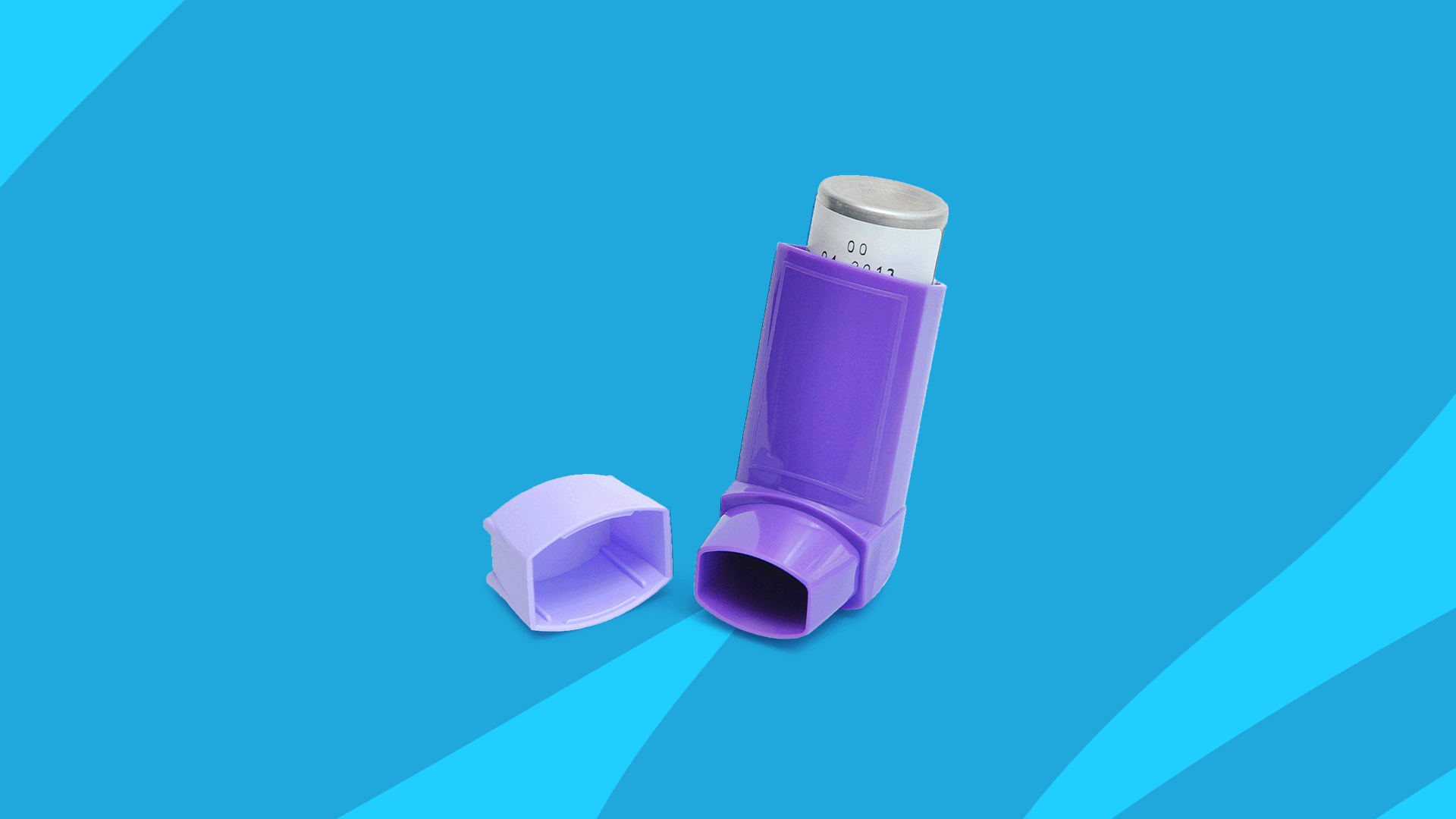Compare Dulera alternatives | Advair | Symbicort | Breo Ellipta | AirDuo | Trelegy Ellipta | Natural alternatives | How to switch meds
Dulera (mometasone furoate and formoterol fumarate dihydrate) is the brand name of an inhaler that has two medications used to control asthma. As a combination inhaler, Dulera contains a corticosteroid (mometasone) and a long-acting beta2-adrenergic agonist (formoterol). Dulera can be an effective inhaler for people with persistent asthma symptoms such as cough, wheeze, chest tightness, or difficulty breathing daily. Dulera works as a bronchodilator to reduce inflammation and open airways in the lungs to improve breathing problems. This inhaler is a maintenance inhaler used twice daily. With two medications in one inhaler, Dulera is a more convenient inhaler option than using two separate inhalers.
Who shouldn’t use Dulera?
While an effective treatment for some people, Dulera may not be the best option for all people managing persistent asthma symptoms. Not all people with asthma will require a maintenance inhaler or a combination maintenance inhaler. People with less persistent asthma may only need a rescue inhaler such as albuterol (Proair HFA or Proventil HFA) or only an inhaled steroid such as fluticasone (Flovent). On the other hand, some people with more severe asthma may require several prescription drug therapies. Some maintenance inhalers for asthma are only approved in certain ages limiting use in some children. Dulera can be used in people 5 years of age and older.
Additionally, some people may be managing not only asthma but also chronic obstructive pulmonary disease (COPD). While Dulera only has FDA approval for use in managing asthma, some alternative inhalers similar to Dulera can be used in both asthma and COPD. However, one of the biggest advantages of some alternatives is that they have become available as generic inhalers that can be more affordable for people.
RELATED: COPD vs. asthma: Which is worse?
What can I take in place of Dulera ?
There are several other brand-name combination inhalers that contain an inhaled corticosteroid (ICS) and a long-acting beta2-agonist (LABA). These inhalers include Advair Diskus, Advair HFA, AirDuo Digihaler, AirDuo RespiClick, Breo Ellipta, and Symbicort. More recently, a few brand-name inhalers (Advair, AirDuo, and Symbicort) became available as generics that include fluticasone propionate/salmeterol and budesonide/formoterol. The two medications in Dulera are not yet available as a generic combination inhaler.
These combination alternative inhalers share common side effects of oral thrush, hoarse voice, upper respiratory infections, sinus infections, and headaches. However, some alternatives have additional adverse effects that should be considered before switching from Dulera.
Compare Dulera alternatives |
|||
|---|---|---|---|
| Drug name | Uses | Dosage | Get coupon |
| Dulera
(mometasone/formoterol) |
Asthma | 2 inhalations of 50-200 mcg/5 mcg by mouth twice daily | Dulera coupon |
| Advair Diskus
(fluticasone/salmeterol) |
Asthma and COPD | 1 inhalation of 100-500 mcg/50 mcg by mouth twice daily | Advair Diskus coupon |
| Advair HFA
(fluticasone/salmeterol) |
Asthma | 2 inhalations of 45-230 mcg/21 mcg by mouth twice daily | Advair HFA coupon |
| AirDuo Digihaler
(fluticasone/salmeterol) |
Asthma | 1 inhalation of 55-232 mcg/14 mcg by mouth twice daily | AirDuo Digihaler coupon |
| AirDuo RespiClick
(fluticasone/salmeterol) |
Asthma | 1 inhalation of 55-232 mcg/14 mcg by mouth twice daily | AirDuo RespiClick coupon |
| Breo Ellipta
(fluticasone/vilanterol) |
Asthma and COPD | 1 inhalation of 100-200 mcg/25 mcg by mouth once daily | Breo Ellipta coupon |
| Symbicort (budesonide and formoterol) | Asthma and COPD | 2 inhalations of 80-160 mcg/4.5 mcg by mouth twice daily | Symbicort coupon |
| Trelegy Ellipta
(fluticasone/umeclidinium/vilanterol) |
Asthma and COPD | 1 inhalation of 100-200 mcg/62.5 mcg/25 mcg by mouth once daily | Trelegy Ellipta coupon |
Other alternatives to Dulera
For people seeking other alternative asthma maintenance treatments, there are single medication inhalers, oral tablets, and injectable options.
Inhaled corticosteroids:
- Alvesco (ciclesonide)
- Arnuity Ellipta (fluticasone furoate)
- Asmanex/Asmanex HFA (mometasone furoate)
- Flovent HFA/Flovent Diskus (fluticasone propionate)
- Pulmicort Flexhaler (budesonide)
- Qvar/Qvar RediHaler (beclomethasone dipropionate)
Long-acting anticholinergic:
- Spiriva Respimat (tiotropium bromide)
Leukotriene receptor antagonists:
Biologics:
- Dupixent (dupilumab) injection
- Fasenra (benralizumab) injection
- Nucala (mepolizumab) injection
- Xolair (omalizumab) injection
Top 5 Dulera alternatives
1. Advair and generics
Advair HFA and Advair Diskus are combination inhalers that can be used to manage both asthma and COPD. Advair contains an ICS (fluticasone propionate) and a LABA (salmeterol).
Unlike Dulera, Advair has generic options available called Wixela Inhub and fluticasone propionate/salmeterol. The generic inhalers may be less expensive options for people.
Advair and the generics can be used in children aged 4 years and older.
Like Dulera, Advair and the generic aerosol inhalers are dosed twice a day.
Advair has similar side effects as Dulera, but also has reports of bronchitis, nausea, and vomiting in people with asthma, and reports of pneumonia and musculoskeletal pain in people with COPD.
RELATED: Dulera vs. Advair
2. Symbicort and generic
Symbicort is a combination inhaler that can be used to manage both asthma and COPD. Symbicort contains an ICS (budesonide) and a LABA (formoterol).
Unlike Dulera, Symbicort has a generic option available called budesonide/formoterol. The generic inhaler may be a less expensive option for people.
Symbicort can be used in children aged 6 years and older.
Like Dulera, Symbicort and the generic inhaler are dosed twice a day.
Symbicort has similar side effects as Dulera but also has reports of back pain, nasal congestion, stomach discomfort, and vomiting.
3. Breo Ellipta
Breo Ellipta is a combination inhaler that can be used to manage both asthma and chronic COPD. Breo Ellipta does not have a generic inhaler available. This alternative contains an ICS (fluticasone furoate) and a LABA (vilanterol trifenatate).
Breo Ellipta is only approved for use in adults aged 18 years and older.
Unlike Dulera, Breo Ellipta is dosed once a day, which may be more convenient for people with asthma or COPD.
Breo Ellipta has similar side effects as Dulera but also has reports of throat pain and bronchitis in people with asthma, and reports of back pain, pneumonia, elevated blood pressure, fever, and joint pain in people with COPD.
4. AirDuo
AirDuo Digihaler and AirDuo RespiClick are combination inhalers that can be used in the management of asthma. This alternative contains an ICS (fluticasone propionate) and a LABA (salmeterol). While this alternative contains the same two ingredients as Advair and the approved generics, it differs as it contains lower doses of salmeterol and is available as a unique inhaler device.
The AirDuo RespiClick has a generic inhaler available and may be a less expensive option.
AirDuo can be used in children aged 12 years and older. Like Dulera, AirDuo is dosed twice a day.
The Digihaler is considered a “smart” inhaler and has built-in sensors to help capture useful information accessible through a mobile app. This data can be shared with doctors and help patients better understand their inhaler use. This alternative may be a great option for people who need feedback on their inhaler technique or require reminders for using their inhaler.
5. Trelegy Ellipta
Trelegy Ellipta is a triple combination inhaler that can be used to manage both asthma and (COPD. Trelegy Ellipta contains three types of medications including an ICS (fluticasone furoate), a long-acting anticholinergic (umeclidinium bromide), and a LABA (vilanterol trifenatate). This alternative may be a great option for people who need additional maintenance therapy.
This combination inhaler does not have a generic option available.
This inhaler is only approved in adults aged 18 years and older.
Unlike Dulera, Trelegy Ellipta is dosed once a day, which may be more convenient for people with asthma or COPD.
With one more medication than Dulera, Trelelgy Ellipta does have more reported side effects including bronchitis, back pain, nasal congestion, altered taste, diarrhea, constipation, urinary tract infection, musculoskeletal pain, pneumonia, nausea, and vomiting.
Natural alternatives to Dulera
While there are no well-supported natural alternative options to Dulera, such as vitamins or supplements, there are alternative remedies that are important for people with asthma to practice. According to the American Lung Association, it’s important to be aware of and minimize asthma triggers that can make asthma worse. By making lifestyle changes or diet modifications, people with asthma can control their asthma symptoms.
Some common asthma triggers include:
- Air pollution
- Animal dander
- Aspirin
- Cigarette smoke
- Dust mites
- Exercise
- Fireplace or campfire smoke
- Food allergies such as peanuts or shellfish
- High humidity
- Mold
- Non-steroidal anti-inflammatory drugs (NSAIDs)
- Respiratory infections (colds, flu, sinus infections)
- Stressed emotions including crying too hard or anger
- Strong odors including cleaning products, scented candles, and air fresheners
- Sudden or extreme changes in temperature
- Trees or grass
An important alternative remedy is learning and utilizing breathing techniques. Pursed lip breathing and belly breathing exercises can be practiced for five to 10 minutes daily that can lead to increased oxygen levels and help rid the lungs of accumulated stale air.
RELATED: 7 home remedies for asthma—and what to do if they don’t work
How to switch to a Dulera alternative
1. Do not suddenly stop taking Dulera
Before stopping Dulera, make an asthma maintenance plan with the prescribing doctor. Suddenly discontinuing Dulera can result in worsening asthma symptoms. Once a plan has been established, Dulera can be safely discontinued and replaced with the new treatment.
2. Learn how to use the new inhaler
There are a variety of different devices that inhalers come in with varying directions for use that require proper technique to make sure the medicine is being delivered correctly. Healthcare professionals, such as a pharmacist, can teach people how to use the inhaler and advise if and how often the specific brand of inhaler needs to be primed. Priming is important to make sure the dosing chamber of certain inhalers fill with the right amount of medication.
RELATED: How to properly administer an inhaler to your child
3. Continue proper oral care with inhaled corticosteroid (ICS) alternatives
Dulera and alternatives that contain a corticosteroid (such as Advair, Breo Ellipta, and Symbicort) require an important step after use. It’s important to rinse the mouth with water, without swallowing, and spit out. This step helps to prevent the increased risk of a fungal infection called oral candidiasis (oral thrush).
RELATED: Oral thrush treatments and medications
4. Do not use Dulera alternatives for sudden asthma attacks
Sudden asthma symptoms such as trouble breathing, wheezing, tightness in the chest, or coughing require a rescue inhaler. Rescue inhalers work quickly to relieve symptoms, whereas Dulera alternatives are maintenance treatments not intended for acute attacks. Rescue inhalers include albuterol (Proair, Proventil, and Ventolin) and levalbuterol (Xopenex). It’s important to discuss with a healthcare provider about the different inhalers prescribed to manage asthma.
5. Discuss all prescription and over-the-counter medications with a healthcare provider
Before switching from Dulera to an alternative, it’s important that the prescribing doctor has reviewed a medication list including prescription drugs and over-the-counter medications. Some alternatives have drug interactions that must be avoided. For example, caution should be used in people using ICS and LABA combination inhalers who are also taking certain antidepressants (such as monoamine oxidase inhibitors and tricyclic antidepressants), ketoconazole, and diuretics. Always consult a healthcare provider for medical advice before changing the treatment plan.











